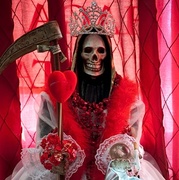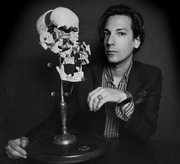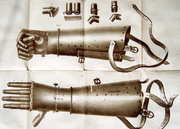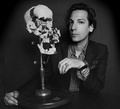
Caitlin Doughty gushes about death like it’s her high-school crush. “I don’t just pretend to love death. I really do love death,” writes Doughty. “I bet you would too if you got to know him.” The young mortician’s web site even includes a checklist of tips for improving your relationship with death, like magazine dating advice (“Spend quality time together,” “Review your expectations,” etc.).
Like a character straight out of HBO’s “Six Feet Under,” Doughty is an unassuming Los Angeles 20-something who’s plunged headfirst into the difficult realities of undertaking. A chance decision to join the industry eventually led Doughty to found the Order of the Good Death, an international organization of artists, writers, and other creative folks interested in changing the way we manage dying. In 2011, Doughty began her popular “Ask A Mortician” web series featured on Jezebel, where she answers viewers’ questions concerning the physical and metaphysical curiosities of dying.
“The 20th century was all about pushing death out of our lens, out of our lives, out of our ideas.”
However, Doughty’s fascination with mortality doesn’t mean she approves of America’s prevalent death rituals, which she finds detached from loved ones and focused on consumerist funerals. As Doughty emphasizes, an important part of understanding death is an awareness of our options, particularly those whose roots go back beyond America’s death-phobic 20th century.
Embalming was the first major step in distancing ourselves from the dead, leading to the establishment of our funerary industrial complex. This modern undertaking practice actually owes its existence to the extreme violence of the American Civil War, which left so many soldiers dead that their bodies couldn’t be shipped home before decomposition began. Despite attempts to keep bodies intact by putting them in iced coolers, railroads began banning corpses on board to avoid the unbearable smells. Soon, President Lincoln approved military surgeons to embalm soldiers whose families could afford the hefty fees, ranging anywhere from $25 to $100 per body, at a time when the average yearly household income was not even $400.

Top: Doughty poses with an old friend. Photo by Darren Blackburn. Above: Embalming methods spread during the Civil War when bodies needed to travel longer distances for burials.
Jessica Mitford’s seminal book, “The American Way of Death” first revealed the manipulative practices of funeral racketeers in 1963. Even then, Mitford expressed the need for a “funeral without fins,” referring to the stripping down of the flashy, expensive tradition that was accepted as the norm. Unfortunately, in recent decades, funerals are increasingly commodified by skyrocketing prices and mourners further distanced by bizarre technologies like tombstone QR codes.
Following in Mitford’s footsteps, Doughty is working on a book documenting the insights of her first year working with the dead, called “Smoke Gets In Your Eyes (and Other Lessons From the Crematory).” Five years after this first crematory job, Doughty’s candid perspective remains an anomaly in an industry whose procedures typically take place behind tightly closed doors. We recently chatted with Doughty about everything from her morbid memorabilia collection to vintage funeral trends.

Doughty with a van full of bodies on their way to the crematory.
Collectors Weekly: How did you get into this profession?
Doughty: I guess it was serendipitous. I was always very into death in school, studying Medieval death rituals and the Victorian Gothic at the University of Chicago. After college, I was living in San Francisco, and I wasn’t happy with what I was doing, so I decided to try working in a crematory.
At the University of Chicago, you don’t do a lot of hands-on, practical things for the most part. And if you go to mortuary school, you’re not usually looking at the death industry with a critical or academic eye. I wanted to see if I could combine those two things. I realized very quickly that if I could somehow work with death on both an intellectual and a practical, tangible level, there might be something there. I worked in San Francisco for a year at a crematory, and then I moved to L.A. for mortuary school.
My upcoming book is about my first year entering this field. I thought I wanted to revitalize the funeral industry by putting the “fun” in “funeral” and having crazy spectacle funerals with champagne glasses or shooting your ashes into space. Then I realized, oh my God, this is actually very gross and difficult. There’s much more here about our relationship with death that we need to deal with, so the book explores that harsh wake-up call moment where I was stumbling through it all confused.

The Los Angeles members of the Order of the Good Death, on a field trip at the urban ruins of the Griffith Park Zoo (Doughty is far left). Photo by Lani Trock.
Collectors Weekly: How would you describe the funerary status quo in America?
Doughty: I’m increasingly told the rituals we have now aren’t really working for people. One reason people are turning to cremation is that they see an embalmed body, and it feels surreal and uncomfortable. Or the funeral is just drab, dreary, and religious, but the dead person was not actually religious. When people see a funeral like that, it doesn’t resonate with them, it doesn’t feel like what they want. Instead of coming up with something new, since we’re not encouraged to be creative about death, people are like, “Well, just cremate me and let’s not talk about it again. Don’t go through any trouble. That was weird, and I don’t want my funeral to be like that.” But we’re missing out on a chance to reinvent our rituals.
The Order of the Good Death is a group of people who are working towards redefining how we do death in the Western world. It includes academics, funeral professionals, artists, writers, and anyone who thinks there’s more to explore with our mourning rituals and body-disposal techniques and how we can improve our acceptance and interaction with death in our culture.
Collectors Weekly: What is it like working with death in Los Angeles, a place notoriously youth- and beauty-driven?

Doughty finds the reproduced artwork and careful manicuring of Forest Lawn’s cemeteries a distraction from dealing with death.
Doughty: When you ask most people to tell you about L.A., they’re like, “Oh, Hollywood, Beverly Hills, dumb bitches, plastic surgery, blah blah.” But that’s an extremely small part of Los Angeles, and living here is a completely different experience. Los Angeles is one of the most diverse places in the world.
The people I deal with in my day-to-day job are absolutely from all racial and economic groups. Especially with cremation, because not only do rich people think it’s the conscious thing to do, but poor people think it’s the only thing to do because that’s what they can afford. This idea of sassy post-mortem beauty for wealthy Hollywood people, that’s not really where I work.
I couldn’t work at Forest Lawn, for instance. Forest Lawn was the original “Let’s make death beautiful and hidden” cemetery. This guy named Hubert Eaton, who called himself “The Builder” in the third person, took over this cemetery in the early 20th century and decided death was horrible and what we need to do is make it more beautiful.
He put a bunch of weird, fake reproductions of famous artworks all through the cemetery and made all of the gravestones flat against the ground so you didn’t have to see them from afar. Eaton said, “We’re not going to call it a cemetery, and there aren’t going to be gravestones or any unsightly reminders of death. It’s going to be a ‘memorial park’ filled with art and none of the things that make death uncomfortable.”
What he did, of course, is create this creepy culture of avoiding death, which the rest of the country owes to L.A. Death is beautiful, but not when you hide it like at Forest Lawn, where all the celebrities are buried. It’s beautiful when you accept the beauty in decay and the visual representations of death.

A contemporary view of the Forest Lawn cemetery in Glendale, where celebrities like Michael Jackson and Elizabeth Taylor are buried.
Collectors Weekly: How has the American funeral evolved?
Doughty: When the Europeans arrived, the Native Americans had all sorts of really fascinating death rituals. They were burned on open-air pyres, or some tribes had large wooden platforms where they exposed their dead to the elements and would come back and use the bones or clean the bones at a later time. But the Europeans saw all this stuff and said, “That’s not Christian. That’s grotesque. You need to stop it.” These interesting death rituals got pushed aside pretty early.
Originally, the way we handled death in America was very simple, something I would ideally like to go back to. If somebody died, the family kept the body in the home. They washed them, wrapped them in a shroud, and then carried them to the graveyard and put them directly in the ground.
Written by Doughty and created with other members of the Order of the Good Death, this short film “The Ecstasy of Decay №2: The American Corpse” explores the history of dying in America.
Collectors Weekly: All within a short time after a person’s death?
Doughty: Yeah, two days or so after the death. But this was in very small towns with communities that could rally to make this happen. There were huge numbers of fatalities during the early years of the American Colonies. Eventually capitalism took over, and death was pulled away from the family.
The first major change was embalming, a chemical treatment of the corpse to preserve it, which is a uniquely American practice. Embalming started during the Civil War, and soon after, anybody could be embalmed, and it was more about creating a standardized product, or what they now call a “memory picture.” Especially in the growing cities, it became clear that taking care of the body yourself was hard emotional work, and people realized they could pay somebody to do it. People who used to be cabinet makers now said, “I can make coffins,” and people who were just dressmakers were like, “I can make funeral mourning clothes,” and all these things now sold as part of the funeral industry.
The services quickly became centralized, with a funeral director or mortician or undertaker, somebody who could take the body away and handle everything. Now the family didn’t have to do any of the hard work around their loved one’s death. This transition happened in the late 19th century, and spilled over into the early 20th century as well.

The visibility of President Lincoln’s funeral procession, from Washington, D.C., to Springfield, Illinois, helped popularize embalming techniques. Image via the Philadelphia Railroad Museum.
Collectors Weekly: Where did embalming techniques come from?
Doughty: They were based on European methods of preserving the body for dissection. Once the body starts decomposing, it becomes a sloppy mess pretty quickly. Into the 17th and 18th century, the anatomical structure of the body was so ill-understood that scientists were developing ways to keep them around a bit longer to study the way organs or the circulatory system worked. They used these same principles to preserve the bodies of soldiers in order to bring them home for burial during the Civil War.
Collectors Weekly: Have there been any major changes to the industry since the early 20th century?
Doughty: The only major change has been cremation, really. It’s nearing the 50-50 mark, where about 50 percent of people are still prepared using the old embalming methods, big caskets, burial, cemetery, etc. The other half is direct cremation, which is where we pick up the body, cremate it, and give the ashes back days later. Cremation is much less expensive, and it’s becoming the culturally conscious thing to do.
Collectors Weekly: Is it also better from an environmental standpoint?
Doughty: Well, it depends. There are definitely environmental issues with cremation, like mercury and carbon emissions. It’s certainly better than traditional burial with the chemical embalming fluids, the hard wood or metal caskets, and the big concrete vaults. But what I advocate for is natural burial, which is basically taking a parcel of land, opening up the ground, and dumping the body in. It’s the most environmentally friendly method because you can reuse that land, and because you’re using it to dispose of bodies, it becomes a conservation area, preserving land that normally wouldn’t be saved.
However, you can’t do any of this in most cemeteries. The vast majority require specific plots, vaults, caskets, headstones, etc. because it’s much easier for them. They make more money, and it’s easier for them to mow the grass because it doesn’t shift and sink. Green or natural burials are legal, but you have to find somebody willing to do it for you.

Dr. Francis Julius LeMoyne opened the first U.S. crematory opened in Washington, Pennsylvania, in 1876 because of his concerns with disease contagion from traditional burial, though the method took decades to catch on. Image via postcardroundup.com.
Collectors Weekly: What funeral traditions do you think we should keep?
Doughty: I think viewing the body is very important; interaction with the dead is helpful for the people who are still living. It’s a memento mori, reminding you that you are going to die and that this person is no longer a part of your life. If you send a body off to be cremated and never see it again, it’s harder to accept that the person is actually gone because as humans we believe what we see. It’s more difficult to fully accept to the loss without seeing the body.
At the same time, dead bodies should look like dead bodies. Corpses should look like corpses. I personally don’t think they should be embalmed; they should be “au natural.” When I’m dead, I don’t want to look like a beautiful maiden who’s still alive, with the blush of youth on her cheeks. I want to look like a corpse because that’s what is going to be helpful to the people who are with my body. It’s something that’s hardly ever done now, though it was done almost exclusively 200 or 300 years ago.
But I’m also interested in new technology and new ways to dispose of our bodies, new ways to understand mourning and ritual. There’s a lot of work we can do with both older traditions and exciting new rituals.
Collectors Weekly: Can you explain the “Ars Moriendi,” or “Art of Dying”?
Doughty: “Ars Moriendi” is a manual that first appeared in the late Middle Ages. It was basically an instructional tract for how to die, or the best ways to die. They’re so fascinating. The book doesn’t have the same relevance now, but it explained how to repent, to get your things in order, the prayers to say. It provided a form of ritual, too. It was like a checklist, helping people move toward a good death.

Ars Moriendi was a Medieval guide to help one prepare for a good death. Image via elefantesdepapel.com.
There’s definitely room for things like that today. Today the questions are, do you have your will, your end-of-life plan, a do-not-resuscitate order, or do you know what you want at your funeral. There’s a great website called “Get Your Shit Together!” that has all these end-of-life forms, and it’s very easy to use. But the general idea is that of an instructional manual, because it’s comforting to feel like you’re ticking off boxes, like you’re moving forward with something and not floating in this abyss, worried about your own death.
There was an experiment done where they went into a nursing home with elderly people, and they gave them a plant to take care of. And they said, “This plant is going to die if you don’t take care of it. You’re responsible for watering and caring for this plant.” And they found that the people they gave those plants to lived significantly longer than those who didn’t have them, because they felt some control over their life, they had some reason to be moving forward and to be taking these daily steps. I think “Ars Moriendi” had a similar purpose: The dying person is given this measure of control over their own death and moving ahead, not just a victim of our medical system where they’re like, “I’m just going to lie here and slowly go crazy and rot and die.”
Collectors Weekly: Why was post-mortem photography adopted as part of the grieving process?
Doughty: Post-mortem photography started just because people could do it. The technology was available for the first time ever, and people were fascinated with the fact that an image could be captured. When photography was first being developed, nobody had pictures of themselves. Often, a post-mortem photograph was often the only image they had of this person. It would be your only visual memory.

A post-mortem photograph from Doughty’s personal collection, likely pre-embalming.
In fact, the late Victorian period was the heyday for long-term mourning and grief. They had mourning jewelry and hair jewelry; funeral rings, cards, or scarves that they gave out at the service; certain types of rosettes that you would put on different doors depending on your type of mourning. Capitalism and production were booming along with the industrial revolution, so we could mass produce things like photographs or rings or printed funeral cards. The technology was there, but we hadn’t yet moved death out of ordinary society. People were still taken care of and dying at home. But when bodies were moved either to the hospital or the funeral home, the communal experience of death was taken away. There was a shift to this American denial of death.
There are a few historians who place World War I as the turning point, because not only did the horror and violence make it necessary to push death from our consciousness, aided by the rise of the medical establishment, the hospital, and the professional funeral home. The 20th century was all about pushing death out of our lens, out of our lives, out of our ideas.

The optical illusion on this trade card suggests the popularity of post-mortem photographs at the turn of the 19th and 20th centuries.
Collectors Weekly: What kinds of death-related objects do you collect?
Doughty: There’s a quote by William Morris that basically says, “Don’t have anything that you don’t know to be useful or believe to be beautiful.” Everything I have fits within a general aesthetic of mourning or death-related or vintage medical objects. I don’t collect things because I’m missing something; I buy things because they’re beautiful and fascinating for somebody visiting my home.
Probably my top aesthetic influence is from vanitas paintings, which are a 17th-century form of memento mori. Vanitas images often feature a skull with either flowers or books or a timepiece, as visual representations to remind you of death. They send the message, “Don’t start thinking how awesome you are or how important you are, because you, too, are on the path to death just like everybody else.”
In addition to post-mortem photos, I have a lot of 19th or early 20th century family photos because they’re memento mori photos for me: These people are all dead, so even though it’s not explicitly showing their dead body, it is a weird reminder of this past person and their death. And I also have a lot of dead things. I don’t agree with killing animals for taxidermy, but I do enjoy things that were either found dead or made in the early 20th century.

“Still Life with Bouquet and Skull” by Adriaen van Utrecht exemplifies the vanitas genre, circa 1642.
I have a lot of my grandmother’s things, like a set of containers made with dead butterflies encased in Lucite plastic, and all sorts of old costume jewelry. All the things in my apartment are my specific treasures, with a story either from my family, an estate sale, or an antique store. But that connects my collection to death as well: My apartment could burn down tomorrow and that would be the end of all the stories of these objects. They have their own life and death, too.
Collectors Weekly: Has America’s consumer culture contributed to our avoidance of death?
Doughty: Hugely. Each time you buy something, you get the rush of being a more complete person because you fear the fact that you’re doomed to die. It took me a while to realize this, but I’ve been collecting items since high school. When I got into the death industry, it took me a couple of years to recognize my impulse to collect was partly mortality fear-based.

Doughty’s home is filled with everything from vintage pharmaceutical devices to taxidermied insects.
I stopped buying anything for a year or two because I was coming to terms with this fact: Am I my collection? How much of my self-esteem am I gaining from having all these items around me? And could I burn it all down and walk away? It took me a while to get to the point where I could stand to imagine my apartment burning down and having to walk away. It would still be terrible, obviously, because I’ve spent years gathering all of these things. But it has to be okay, because the world is in constant transition and flux and these things happen all the time.
If there were a war, we could be bombed. And because we’re in California, my apartment could crumble in an earthquake. You can’t control the objects on the outside of you. The only thing you can really collect is your knowledge, what’s in your brain and what sort of person you can be.
Collectors Weekly: Has social media changed the dying process?
Doughty: Well, I think there needs to be more specific discussion about that. Facebook needs to have better policies on what to do when people die, and every user should have to say what they want. It would be an excellent memento mori experience if you got a message from Facebook saying, “Hey, what’s the email for the person you’re going to allow to declare you dead?” Or, “If we find out you are dead through official means, do you want us to shut down your Facebook page?”
There are a lot of unasked questions about it. Do you want to be memorialized where your profile becomes a place that people can write things after you die, like an obituary page? Do you want to stop or freeze it as is? This needs to be discussed, and it’s going to be confusing and weird and awkward. This is not an old, time-immemorial problem; this is a problem specific to our modern technological landscape. In all areas of computer technology, there’s a woeful lack of people involved in this conversation.

Early examples of trick photography were used to create funeral tableaus, like image of a young girl collaged onto floral arrangements, circa early 1900s.
Collectors Weekly: Are there ways we can use technology to improve the grieving process?
Doughty: There are artists I work with, like Jae Rhim Lee and Pia Interlandi, whose work involves the post-mortem body. Pia designs decomposing burial shrouds and Jae Rhim created a “mushroom burial suit,” which uses mushrooms to eat the toxins out of our body when we die. That type of technology doesn’t so much help with the grieving process as it provides an entry point for people to talk about death because they love these ideas. People love sharing links and talking about it because they are fascinated with the possibilities it opens up, and that discussion helps normalize death in a way.
The more you’re interacting with death before you die, the more the grieving process isn’t about you. I think the problem with grieving today is that people become focused on their own mortality, and they get caught up in that when somebody they know dies. Anything we can do to make death a part of everyday culture is important because you’ll be more ready to grieve for someone else when the time comes.

 Mummies and Monkey Skulls: 'Oddities' Host Ryan Matthew Cohn on Creepy Antiques
Mummies and Monkey Skulls: 'Oddities' Host Ryan Matthew Cohn on Creepy Antiques
 Learning to Love Death: New Museum Takes a Walk on the Shadow Side
Learning to Love Death: New Museum Takes a Walk on the Shadow Side Mummies and Monkey Skulls: 'Oddities' Host Ryan Matthew Cohn on Creepy Antiques
Mummies and Monkey Skulls: 'Oddities' Host Ryan Matthew Cohn on Creepy Antiques War and Prosthetics: How Veterans Fought for the Perfect Artificial Limb
War and Prosthetics: How Veterans Fought for the Perfect Artificial Limb Mourning JewelryMourning jewelry has been around since at least the 16th century, but it is…
Mourning JewelryMourning jewelry has been around since at least the 16th century, but it is… Mari Tepper: Laying it on the Line
Mari Tepper: Laying it on the Line Nice Ice: Valerie Hammond on the Genteel Charm of Vintage Canadian Costume Jewelry
Nice Ice: Valerie Hammond on the Genteel Charm of Vintage Canadian Costume Jewelry How Jim Heimann Got Crazy for California Architecture
How Jim Heimann Got Crazy for California Architecture Modernist Man: Jock Peters May Be the Most Influential Architect You've Never Heard Of
Modernist Man: Jock Peters May Be the Most Influential Architect You've Never Heard Of Meet Cute: Were Kokeshi Dolls the Models for Hello Kitty, Pokemon, and Be@rbrick?
Meet Cute: Were Kokeshi Dolls the Models for Hello Kitty, Pokemon, and Be@rbrick? When the King of Comedy Posters Set His Surreal Sights on the World of Rock 'n' Roll
When the King of Comedy Posters Set His Surreal Sights on the World of Rock 'n' Roll How One Artist Makes New Art From Old Coloring Books and Found Photos
How One Artist Makes New Art From Old Coloring Books and Found Photos Say Cheese! How Bad Photography Has Changed Our Definition of Good Pictures
Say Cheese! How Bad Photography Has Changed Our Definition of Good Pictures Middle Earthenware: One Family's Quest to Reclaim Its Place in British Pottery History
Middle Earthenware: One Family's Quest to Reclaim Its Place in British Pottery History Fancy Fowl: How an Evil Sea Captain and a Beloved Queen Made the World Crave KFC
Fancy Fowl: How an Evil Sea Captain and a Beloved Queen Made the World Crave KFC
Fascinating!
Caitlin rocks. Her matter-of-fact approach to death is so refreshing.
Best interview ever. She has such a fresh healthy perspective about death and communicates her philosophy beautifully…..with the help of a creative interviewer.
Caitlin refers to the historical relevance and potential contemporary benefits of family and community centred, home based post death care. Others are also working hard to elucidate the legal rights, cost savings, environmentally conscious and potential therapeutic benefits of “home funerals” as well, in fact the movement is well underway in the US and is gaining momentum in Canada now too. Search the National Home Funeral Alliance, the Funeral Consumer’s Alliance, the Funeral Ethics Org and the Green Burial Council for additional reading and information on this important and culturally relevant topic!
My family’s funeral home has been in business for almost 100 years. I grew up living above the funeral home. I appreciate Doughty’s views on death, grieving and funerals. Funerals are very expensive and I feel that people need more options for burials. Burials and cremations are the most common forms but I like the idea of putting an unembalmed body in the ground. It’s a very natural way to dispose of a body. I don’t want to be embalmed and have make up put on my face….I’m dead! Just cremate me or bury me without embalming me.
While I’m glad to see someone challenging the predatory practices of the funeral industry, I would also point out that she is in her 20s; by definition, she has not yet accepted her own mortality. That realization doesn’t truly happen until late middle age. It is something that occurs on a level beyond intellect, an internalization with which everyone who lives long enough comes to terms, one way or the other. Every young person thinks they understand the reality of death and mortality — until they’re no longer young and realize they didn’t understand a thing.
I would like to see the formation of parks where a person’s body can be respectfully placed in the ground and used to nurture trees and flowers and perhaps even help repopulate bees and other living things to memorialize a person while celebrating and contributing to life rather than wasting space.
It’s your life and your death, have whatever kind of send-off you want. It’s nobody else’s business. If you want to be unceremoniously dumped into a hole in the ground, then do that. If you want a big fancy affair, then do THAT. Cremation, burial at sea, launched into orbit – do whatever you want. Don’t let environmental fear-mongering and anti-funeral home propaganda bully or shame you into not going out exactly as you wish. Yes, there are unscrupulous people in every profession, but there aren’t ONLY unscrupulous people… there are plenty of wonderful people who own and operate funeral parlors who aren’t in it to bilk the bereaved for all their worth. And the business of death is not nearly as environmentally detrimental as hysterics would have you believe. Personally, I like the idea of the tree-thing, but really IDGAF about what happens to my husk once I’m kaput. I just am a little irked by some misrepresentations in this otherwise delightfully macabre article.
Hunter and Caitlin….Thank you for this realistic and progressive glimpse